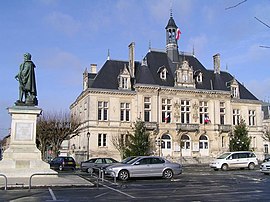Saint-Jean-d'Angély
show This article may be expanded with text translated from the corresponding article in French. (December 2008) Click [show] for important translation instructions. |
Saint-Jean-d'Angély | |
|---|---|
Subprefecture and commune | |
 The town hall in Saint-Jean-d'Angély | |
 Coat of arms | |
show Location of Saint-Jean-d'Angély | |
 Saint-Jean-d'Angély | |
| Coordinates: 45°56′48″N 0°31′46″W / 45.9466°N 0.5294°WCoordinates: 45°56′48″N 0°31′46″W / 45.9466°N 0.5294°W | |
| Country | France |
| Region | Nouvelle-Aquitaine |
| Department | Charente-Maritime |
| Arrondissement | Saint-Jean-d'Angély |
| Canton | Saint-Jean-d'Angély |
| Government | |
| • Mayor (2020–2026) | Françoise Mesnard[1] (PS) |
| Area 1 | 18.78 km2 (7.25 sq mi) |
| Population (Jan. 2018)[2] | 6,886 |
| • Density | 370/km2 (950/sq mi) |
| Time zone | UTC+01:00 (CET) |
| • Summer (DST) | UTC+02:00 (CEST) |
| INSEE/Postal code | 17347 /17400 |
| Elevation | 8–76 m (26–249 ft) (avg. 4 m or 13 ft) |
| 1 French Land Register data, which excludes lakes, ponds, glaciers > 1 km2 (0.386 sq mi or 247 acres) and river estuaries. | |
Saint-Jean-d'Angély (French pronunciation: [sɛ̃ ʒɑ̃ dɑ̃ʒeli] (![]() listen)) is a commune in the Charente-Maritime department in southwestern France.
listen)) is a commune in the Charente-Maritime department in southwestern France.
The commune has its historical origins in the Abbey of Saint-Jean-d'Angély.
Royal abbey[]
Founded in the ninth century to house a relic of Saint John the Baptist, and rebuilt in the 14th, 17th and 18th centuries because of repeated destruction, then later abandoned, the Abbey is now a listed building. It remains the most remarkable piece of architecture of Saint-Jean-d'Angély, a town which has kept all its medieval charm. Situated on the pilgrim route that led to Santiago de Compostela[3] the edifice still constitutes a major stopping-off point towards Santiago de Compostela. Since 1989, the Royal Abbey has housed the Centre of European Culture, which has breathed new life into the Abbey by restoring it as a historical and cultural site and as a place for the exchange of ideas.
From 1989 to 1997, the restoration of the monastic buildings has been carried out according to the needs of the Centre of European Culture, with an emphasis placed on accommodations, catering, as well as rooms for conferences, reunions and workshops. The Centre has been at the forefront of the revitalization of the building, to such a point that today the Centre and the Abbey have been linked in the minds of the residents.
Centre of European culture[]
The Centre of European Culture at Saint-Jean-d'Angély, created in 1989 as a joint initiative taken by the Minister of Culture, the town of Saint-Jean-d'Angély, the regional council of Poitou-Charentes and the council of Charente Maritime, has hosted multinational sessions focused on European culture and citizenship that are dedicated to youngsters sixteen to nineteen years, coming from all European countries.
Modern Saint-Jean[]
Saint-Jean-d'Angely is now home to a vibrant and bustling town centre, with a twice-weekly market (on Saturdays and Wednesdays). Also present is a swimming and fitness centre, Atlantys, which is situated on the edge of the town.
Geography[]
The Boutonne flows northwest through the commune; the town lies on its right bank.
Twin towns – sister cities[]
 Koumondè, Togo
Koumondè, Togo Mondsee, Austria
Mondsee, Austria New Iberia, United States
New Iberia, United States Saint-Sulpice, Canada
Saint-Sulpice, Canada
Population[]
|
|
|
|
See also[]
References[]
External links[]
| Wikimedia Commons has media related to Saint-Jean-d'Angély. |
- Communes of Charente-Maritime
- Subprefectures in France
- World Heritage Sites in France
- Saintonge


